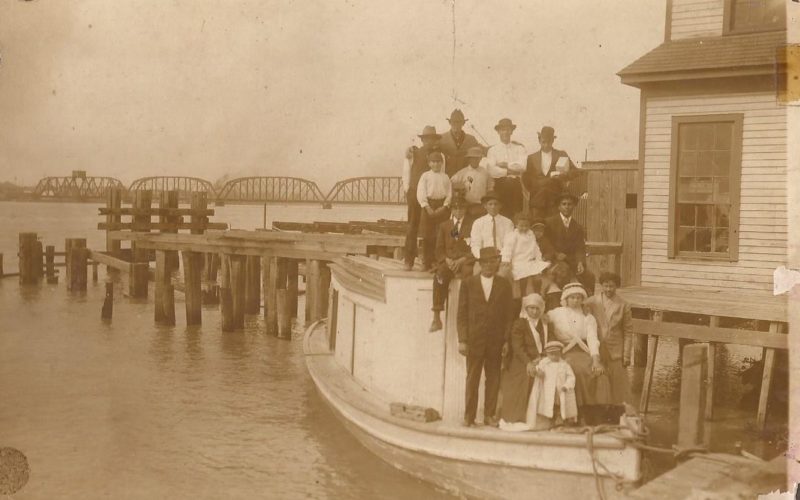
The Leco family’s boat.
I wanted to know about my dad and where his family was from; my family. It was very rarely that we saw my dad’s side of the family.
Shelbey: Who were your grandparents?
Vinnie: Pierre Leco, Alberta Leco, Earl Boudin Sr., and Gladys Guidry Boudin.
Shelbey: Do you remember them? Could you tell me about them. Where were they from?
Vinnie: Yes, I remember them. I know my mother’s parents are from Raceland, and I know they’re from Cajun French descent. I know my dad’s parents are from German and Filipino descent and they were from Dulac, south of Houma.
Shelbey: What were they like? Did they do anything in particular that you could remember?”
Vinnie: I remember making blackberry dumplings and cooking seafood-based products. I remember eating dried shrimp over there. That’s the kind of stuff they did every day. They went out south of Houma and in Grand Caillou, and caught shrimp. They would boil the little bitty ones and put’em out in the sun. They would dehydrate them. After, they put’em in a sack and make all the peelins fall off by beating the sack around. That’s what you see in them little packages at the store.
Your paternal great grandparents were out working in Manila Village. It was a reef that was built off of oyster shells. It was a farmer’s market with a general store on water with seafood. They would trawl, and trap muskrat, otter, nutria, mink, rabbits, pelts. They would go out and shuck the oysters there with the oyster boat. They’d load’em and shuck them there. Instead all the boats coming up through Lafitte, they would stay there in Manila Village and off-load their stuff. They had bigger boats that would process the stuff all right there and ship it ‘upfront.”
Shelbey: “Up the river?”
Vinnie: Up the Barataria waterway. They called it Manila Village because there were a lot of Filipinos there. I was Filipino on my dad’s side. My grandpaw was out there. You’d see’em sittin’ oon top of oyster shells. My great-grandpaw came from the Philippines and was part of the Filipino movement comin in. My grandparents were born and raised out there. That’s how they were livin. My parents were part’a that too, but they started migrating “upfront.” All you can see now of Manila Village is on your depth finder. You can see the water go from 5 feet…4…4…3…2…1. Then it’s a circle in the water and they got some pickets there that’s the only thing left. Over time, it just washed away.
Shelbey: You went there?
Vinnie: Yeah, I fished there. When I first went there, it was only a piling of oyster shells. I went in the 80’s and 90s, the piling was sticking out the water. You could still see a couple of the oyster shells.
Shelbey: Did Paw Paw go out there?”
Vinnie: Yeah, when he was little. I mean, his daddy was there. His brothers were there. He the baby of the family, but when we was five and six years old, he was out there. When he came back from school, he went out there. On the weekend, he was out there.”
I came from a family of fisherman who worked day in and day out on the oyster reef they called Manila Village.
 Big Chem-EZ: Why is southeastern Louisiana heavily impacted by storms?
This article explores the positive and negative impacts of the engineering industry on Louisiana, including how it is impacted by storms. The author also suggests a call to action to support Louisiana coastal restoration. Big Chem-EZ discusses how finding the best course of action can be challenging, and introduces various proposed solutions to wetland loss and environmental impacts on Louisiana industries.
Big Chem-EZ: Why is southeastern Louisiana heavily impacted by storms?
This article explores the positive and negative impacts of the engineering industry on Louisiana, including how it is impacted by storms. The author also suggests a call to action to support Louisiana coastal restoration. Big Chem-EZ discusses how finding the best course of action can be challenging, and introduces various proposed solutions to wetland loss and environmental impacts on Louisiana industries.
 Waves of Change–The Impact of Political Tides on Louisiana’s Environmental Future
Healthy Gulf has been a cornerstone in safeguarding Louisiana’s natural and human resources through sustainable and equitable practices. But a new threat looms with Governor Jeff Landry’s recent consolidation proposal, which aims to merge crucial coastal management with the Department of Energy and Natural Resources. Writer Leah Claman delves into the complexities of this proposal, breaking it down for those unfamiliar with environmental policy, and sheds light on what this could mean for the future of Louisiana’s coast and its communities.
Waves of Change–The Impact of Political Tides on Louisiana’s Environmental Future
Healthy Gulf has been a cornerstone in safeguarding Louisiana’s natural and human resources through sustainable and equitable practices. But a new threat looms with Governor Jeff Landry’s recent consolidation proposal, which aims to merge crucial coastal management with the Department of Energy and Natural Resources. Writer Leah Claman delves into the complexities of this proposal, breaking it down for those unfamiliar with environmental policy, and sheds light on what this could mean for the future of Louisiana’s coast and its communities.
